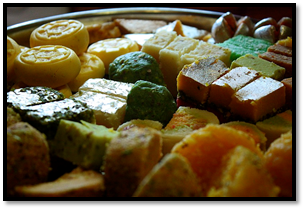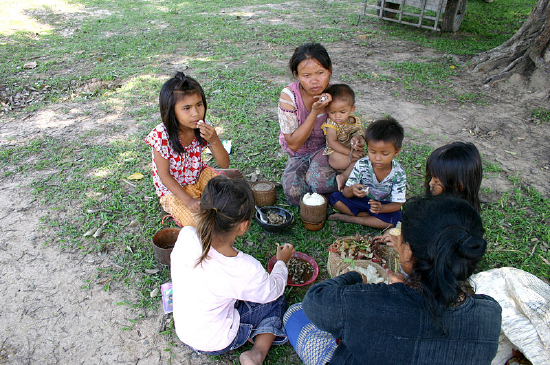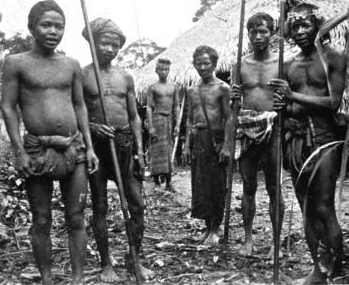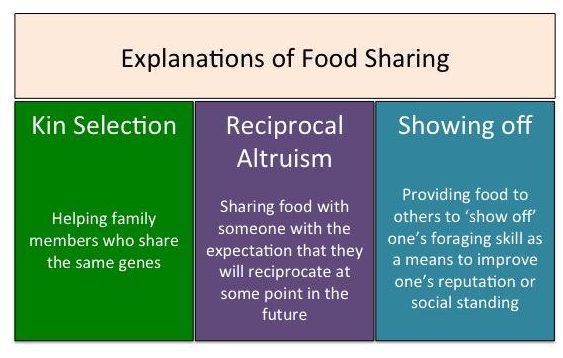19.1: Human Behavioral Ecology
- Last updated
- Save as PDF
- Page ID
- 177835
Evolutionary History
Natural selection is the force of evolution whereby individuals with heritable traits that result in greater survival and reproduction have more offspring than individuals without those traits. By having more offspring (specifically, offspring who themselves survive and reproduce), these heritable traits become more common in future generations. As an example, hominin brain size has increased dramatically over the past two million years. Our ancestors with larger brains were better able to survive and reproduce than those with smaller brains, possibly because they were better able to acquire food or navigate the social complexities of living in a large group (Dunbar 1998; Parker and Gibson 1979).
 Figure \(\PageIndex{1}\): Sample of sweets to celebrate Diwali, a Hindu festival of lights.
Figure \(\PageIndex{1}\): Sample of sweets to celebrate Diwali, a Hindu festival of lights.Human behavioral ecology uses the theory of evolution by natural selection to understand how modern behaviors were advantageous in our evolutionary history. For most of human history, humans lived as hunter-gatherers, meaning they collected or hunted food; they typically resided in small communities with individuals related through blood or marriage; and they had no access to modern medicines or other modern conveniences. It is useful to think about this environment—which is much different than how humans live today—to help us understand how current behaviors may have evolved. For example, humans today enjoy consuming food high in fats and sugars (see Chapter 16; see Figure 19.1.1). In the past, eating fatty and sugary food was a good survival strategy since food was limited in a hunter-gatherer’s environment, and these foods contained a lot of calories. Over time, those individuals who sought out these foods were probably better able to survive and reproduce, resulting in a population of people today who have preferences for these foods. In modern environments, where food is abundant, this preference has likely contributed to the obesity epidemic, which increases people’s risk of cardiovascular diseases and no longer improves people’s ability to survive and reproduce.
Ecology
In addition to evolutionary history, the field of human behavioral ecology also focuses on the influence of ecology. Ecology is defined as one’s physical environment, including types of resources, predators, terrain, and weather, as well as one’s social environment, including the behaviors of other individuals and cultural rules. For example, if one lives in an environment where there are abundant fruit trees, then one’s diet likely includes fruit. Since fruits are easy to acquire, children can engage in food gathering at young ages. In contrast, in environments like the Arctic, where there are fewer plant resources, the diet focuses more on hunting and fishing. Since these skills take longer to acquire, children may only be able to contribute to their own subsistence at older ages. One’s environment influences the behaviors in which individuals engage, such as children’s foraging.
Another component of ecology is one’s social environment, including cultural rules. Throughout the world, different cultures have quite different norms of behavior. For instance, in some societies marriages are required to be monogamous, meaning that a marriage is between just two individuals. This is a cultural norm in American society, and it is illegal to violate this rule. In other societies, marriages can occur between one man and several wives or one woman and several husbands, referred to as polygyny and polyandry respectively. If you are in a society where monogamy is the rule, then this will influence people’s behavior, as each individual knows that they can only marry one other individual at a time. This may influence who they choose to be their partner. In polygynous cultures, the age difference between husbands and wives tends to be larger than it is in monogamous cultures, as the men who are able to attract additional wives tend to have high status or wealth and are typically older than the women who are available for marriage. One’s environment (both physical and social) influences one’s behavioral options, and human behavioral ecologists examine how one’s ecology influences people’s behavior. In Figure 19.1.2, we see a visual depiction of the field of human behavioral ecology, using evolutionary history and ecology (physical environment plus culture) to explain modern human behavior.
 Figure \(\PageIndex{2}\): Human behavioral ecology.
Figure \(\PageIndex{2}\): Human behavioral ecology.Both Genes and Environment Influence Behavior
While physical characteristics (like height) are clearly heritable, we also know that they depend on the environment. When children grow up with poor nutrition and do not ingest enough calories, their growth is stunted. At the same time, if your parents are both tall, then you are more likely to be tall as well. Physical traits are the result of both genes and environment. Behavior is the same—dependent on both genes and environment. While there are no genes for specific behaviors, behavioral tendencies do show some level of heritability. Personality disorders, for instance, may be partially heritable, but it also depends on the environment in which a child is raised—for example, where there is child neglect or sexual abuse, there is a corresponding increased risk of personality disorders (Johnson et al. 1999).
Human behavioral ecologists assume that even though there are not genes for specific behaviors, genes may influence behavioral tendencies. Additionally, behaviors are flexible and people use information from the environment to determine how they should behave. For example, the ability to cooperate has evolved over evolutionary time, but whether or not an individual cooperates in a particular instance likely depends on the situation. Research shows that people are more likely to cooperate if (1) their behavior is known to others (that is to say their identity is not anonymous), (2) it will improve their reputation, or (3) they will be punished for not cooperating (Andreoni and Petrie 2004; Fehr and Fischbacher 2003; Milinski, Semmann, and Krambeck 2002).
HOW CAN HUMAN BEHAVIORAL ECOLOGY HELP US UNDERSTAND ALTRUISM
Altruism is defined as providing a benefit to someone without expecting anything in return. A perfect example is donating money to tsunami victims. From an evolutionary perspective, it seems that providing benefits to others would be disadvantageous for one’s own survival and reproduction, as resources given to others are resources that cannot be used for oneself. But people do engage in altruistic behaviors, so how can the field of human behavioral ecology help us understand this behavior? We will use the example of food sharing to think about different ways human behavioral ecologists have examined this question. In many small-scale hunter-gatherer societies, people share food extensively with other people living in their communities. This sharing is most widespread when the item is a hunted animal, which can typically feed many people. Just as giving away money seems counterintuitive, so does giving away food. So, why do people in these foraging communities share so much food with each other?
Kin Selection
 Figure \(\PageIndex{3}\): Lao family eating together.
Figure \(\PageIndex{3}\): Lao family eating together.One of the first explanations for why humans share food is that they are sharing with their close family members. Kin selection proposes that individuals help kin, even at a cost to themselves, because this help is directed at individuals with whom they share genes (Hamilton 1964). If we think of evolution from a gene’s eye view, then individuals should care about passing on their genes. Since family members share genes, this may explain why kin help one another. Figure 19.1.3 shows a Lao family eating together. It is very common around the world for families to share food with one another. In many small-scale societies, people share food with family members but also with those who are not family members. Kin selection helps explain some food sharing, but it doesn’t explain all food sharing.
Reciprocal Altruism
 Figure \(\PageIndex{4}\): Jakun hunting party.
Figure \(\PageIndex{4}\): Jakun hunting party.Another potential explanation for why humans share food is that they are engaging in reciprocal altruism, meaning that an individual shares food today with the expectation of repayment at some point in the future (Trivers 1971). This can work well, unless the person who receives the help chooses not to reciprocate in the future. In this case, the original sharer does not obtain anything in return. To maintain these relationships, it is important that individuals have the opportunity to share with one another repeatedly and that if one person chooses not to reciprocate, the original sharer terminates their sharing. Reciprocal altruism is even more likely to occur if the value of the food is greater to the person receiving the food than the person sharing the food. For instance, imagine that you have an entire pizza. After you eat several slices, you are no longer hungry and the next piece of pizza has little value to you. In contrast, if you are hungry, receiving a slice of pizza from a friend would mean a lot to you. In this case, the person giving a piece of pizza after already eating their fill is giving away something of little value, but the person receiving a slice of pizza when they are hungry is receiving something with substantial value. If the following week, the roles are reversed, then in both cases, the person receiving the food has received something of greater value than has the person who gave it away. This makes sense in the case of sharing hunted meat as well. When hunters kill an animal, it is typically a large animal with a lot of meat. In environments without refrigeration technology, leftover meat has little value as it is likely to spoil. In contrast, sharing that meat with hungry community members has a lot of value to those receiving the meat. Then, at some point in the future, the person who received the meat may successfully hunt and share with others. Figure 19.1.4 displays an indigenous hunting party from Malaysia. Food is widely shared in small-scale societies, particularly when the item is large in size and when there is a lot of uncertainty around when the next successful hunt will occur (Gurven 2004). But, as with other skilled activities, some individuals are better hunters than others and acquire more meat than others consistently, so why would highly skilled hunters give more food to low-skilled hunters than will be reciprocated? Again, reciprocal altruism is one piece of the story but cannot explain all sharing behavior.
The “Show-Off” Hypothesis
Another possible explanation for why people share food, particularly meat in small-scale societies, is because they want to display their skills as a hunter to their community, termed the show-off hypothesis (Hawkes 1991). As a social species, an individual’s success relies on what others think of them. Providing resources to the community may help attract mates, friends, and allies. Those that share are likely to be viewed as good cooperators and worth having around. Among the Melanesian Meriam Islanders, evidence shows that turtle hunting during the breeding season, which is highly risky and unpredictable, is only done by unmarried males (Bliege Bird and Bird 1997). Turtle hunting during the nesting season, which is relatively easy and low risk, is done by males of all ages. This suggests that unmarried males engage in risky hunting to signal their skills as a hunter and cooperator. Again, while some sharing behavior may be best explained by a desire to show off, it cannot explain all sharing behavior.
 Figure \(\PageIndex{5}\): Explanations of food sharing.
Figure \(\PageIndex{5}\): Explanations of food sharing.Examining these three explanations of sharing behavior (Figure 19.1.5)—kin selection, reciprocal altruism, and “showing off”—helps explain a lot of sharing seen around the world, but donating money to tsunami victims is still hard to understand. Most Americans were not related to the victims of the tsunami and they probably do not expect reciprocation. It is possible that people were doing it to show off, although it seems unlikely that many people used it as a means to improve their reputation. While some charitable giving may be explained by the tax incentives, the donations to the tsunami victims were so extensive that it seems unlikely to be the main explanation. People commonly state that they donate because “it makes them feel good.” While helping others does make people feel good, this likely evolved because those that had the feel-good sensation helped others—like their kin—resulting in greater survival and reproduction. The “feel good” sensation is a proximate mechanism, the immediate explanation, while human behavioral ecology seeks to understand the ultimate explanation, or deep evolutionary reason that this trait led to increased survival and reproduction. In the case of donating money to people living on the other side of the world, our modern environment (allowing us to help people living so far away) may lead us to act in ways that were adaptive in our evolutionary past but that may not improve our survival or reproduction today.
At the same time, we struggle to solve the problem of homelessness across the United States. Using evolutionary theory may help us understand why people are unable to come together to eliminate this problem. Eradicating homelessness would be costly, would require the cooperation of lots of individuals (no single individual or small group can solve it on their own), and would be ongoing. This type of long-lasting commitment to help unrelated strangers may be difficult to acquire from large enough numbers of people to make an impact.

